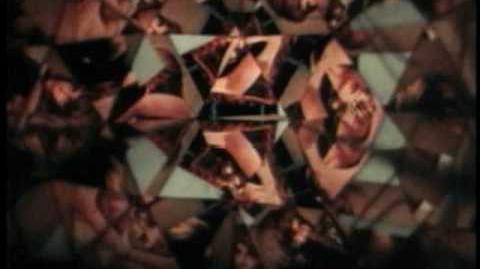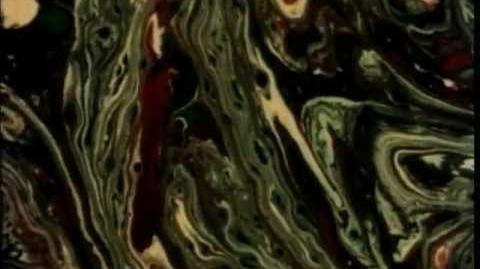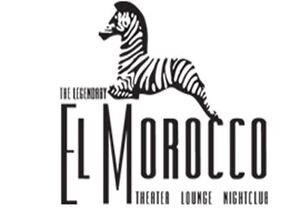BradFraggle (talk | contribs) No edit summary |
Tag: Source edit |
||
| (13 intermediate revisions by 6 users not shown) | |||
| Line 1: | Line 1: | ||
| − | [[File: |
+ | [[File:Cyclianightclub.jpg|thumb|300px|Jim Henson's artwork for the nightclub exterior.]] |
| − | [[File:Cyclianightclub. |
+ | [[File:Cyclianightclub-inside.png|thumb|300px|Jim Henson's artwork for the nightclub interior.]] |
| − | '''''Cyclia''''' was a nightclub project which [[Jim Henson]] worked on from [[1967]] to [[1970]]. ''Cyclia'' was envisioned as a multimedia experience that would feature a large room with film footage projected onto a faceted ceiling and body-suit clad dancers, timed to correspond with specific musical tracks, live musical performers, and various lighting effects. |
||
| + | '''Cyclia''' is a concept for a nightclub that [[Jim Henson]] developed from [[1965]] to [[1968]]. Cyclia was described as "the entertainment experience of the future—a theater of the year 2000."<ref name="redbook">[[Jim Henson's Red Book]]: [http://www.henson.com/jimsredbook/2011/07/05/7-1967/ 7/–/1967 – ‘In LA with Barry C. showing “Cyclia”.’]</ref> |
||
| ⚫ | The project's sales brochure called it "a sensational glimpse into the inner contents of our |
||
| + | Henson envisioned that the walls, floors, and ceiling of the club would be broken into faceted, crystal-like shapes onto which films would be projected—completely immersing patrons in a sea of images, choreographed precisely to the volume and type of music being played. Once an hour, a woman in a white leotard would rise from a pedestal in the center of the floor to have film projected on her body as she danced. It would be, as Henson proposed, a very fashionable place, with "a definite prestige atmosphere and as such [the cover charge] would not be inexpensive."<ref name="JHTB">''[[Jim Henson: The Biography]]'' by [[Brian Jay Jones]] (pages 124-126)</ref> |
||
| − | Thousands of feet of film were shot, and never used. The project never came to fruition, leaving only a few reels of film and some sketches which can be seen in the book ''[[Jim Henson: The Works]]''. |
||
| + | [[Jane Henson]] recalled the project's genesis: "The idea began during the first wave of psychedelia. Jim went to see Jefferson Airplane and was very intrigued with it—the light show and psychedelic graphics."<ref name="JHTB" /> |
||
| − | ==Videos== |
||
| + | |||
| − | <gallery> |
||
| ⚫ | The project's sales brochure called it "a sensational glimpse into the inner contents of our times—a vital, living, expanding experience that consumes its audience. It is total involvement, total communication."<ref>[http://www.oscars.org/filmarchive/collections/henson.html Academy of Motion Picture Arts and Sciences Film Archive: The Jim Henson Collection]</ref><ref name="redbook">[[Jim Henson's Red Book]]: [http://www.henson.com/jimsredbook/2011/07/05/7-1967/ 7/–/1967 – ‘In LA with Barry C. showing “Cyclia”.’]</ref> |
||
| + | |||
| + | ==''Cataclysm''== |
||
| + | The club would feature an hour-long film called '''''Cataclysm''''' that would be projected constantly on the walls and bodies. Henson began shooting film for the project as early as 1965. |
||
| + | |||
| + | In August 1965, [[Frank Oz]] and [[Jerry Nelson]] were sent to film the crowd during [[the Beatles]] concert at Shea Stadium. Other footage collected included filming city streets from the back of a motorcycle, rain rippling through puddles, wooded landscapes, psychedelic kaleidoscope footage, and original cut paper animations.<ref>''[[Imagination Illustrated]]'' by [[Karen Falk]] (page 52-53)</ref> |
||
| + | |||
| + | Frank Oz commented on the project: |
||
| + | {{quote|I shot thousands and thousands of feet of sixteen-millimeter film for Cyclia. It's where I got the first experience that enabled me to become a movie director. But you couldn't shoot just random stuff, Jim was actually thinking thematically. Since there would be sixteen projectors showing images, they had to be thematically sound—like sixteen screens of people screaming at the Beatles.<ref name="JHTB" />}} |
||
| + | |||
| + | Henson had thirteen different themes in mind—all of which would be edited together into ''Cataclysm''. These themes included: "Woods," "Junk," "City at Night," "India," and "Nude."<ref name="JHTB" /> Music used throughout the film included tracks by the Beatles, Jefferson Airplane, [[Paul Simon|Simon]] & [[Art Garfunkel|Garfunkel]], and [[the Rolling Stones]], among others. |
||
| + | |||
| + | <gallery widths=200 spacing=small> |
||
File:Cyclia |
File:Cyclia |
||
File:Jim's Red Book "Cyclia" |
File:Jim's Red Book "Cyclia" |
||
File:Jim's Red Book "Cyclia" Kaleidoscope |
File:Jim's Red Book "Cyclia" Kaleidoscope |
||
</gallery> |
</gallery> |
||
| + | |||
| + | ==Location== |
||
| + | [[image:ElMorocco.jpg|right|300px]] |
||
| + | Henson hired [[Barry Clark]], who had experience managing musicians and clubs, to scout possible locations and help find investors; and Cyclia Enterprises was officially incorporated in the fall of 1967 to help manage the project. |
||
| + | |||
| + | In 1966, Henson considered purchasing and converting ABZ Studios, a set of buildings at 266-268 East 78th Street in [[New York City|Manhattan]], to house the club. However, legal difficulties arose with the property and Henson began looking at other locations—including a building on West 60th Street, just off Central Park; a building in Santa Monica, [[California]], and a vacant lot on Second Avenue in New York City at the foot of the Queensboro Bridge where Henson proposed building a geodesic dome or even creating an inflatable structure.<ref name="JHTB" /> |
||
| + | |||
| + | Henson also explored the idea of a joint venture with the El Morocco club on [[Broadway]] to take over the club's Garrison Room. El Morocco would deal with all club operations and [[The Jim Henson Company|Muppets Inc.]], responsible for providing the "motion picture footage," would get 50% of the profits. The two parties would also share future franchising of the concept to other locations.<ref>[[Jim Henson's Red Book]]: [http://www.henson.com/jimsredbook/2013/02/07/2-1967/ 2/–/1967 – ‘Talking to El Morocco re-Cyclia.’]</ref> |
||
| + | |||
| + | ==Eventual abandonment== |
||
| + | Despite trouble selling the project and finding a location, Henson remained committed to Cyclia throughout much of 1967 and '68—running multiple cost analyses, editing a rough cut of ''Cataclysm'', creating floor plans, painting concept art and distributing fluorescent-colored brochures to potential backers.<ref name="JHTB" /> While sense-soaking, high-tech themed nightclubs would become fashionable by the late 1970s, in the mid-1960s, Henson struggled to find the necessary space, materials, and technology to make it happen. |
||
| + | |||
| + | Eventually the idea was abandoned as Henson moved on to other projects (such as the production of ''[[Hey Cinderella!]]'' and the start of ''[[Sesame Street]]''); Barry Clark left the project in August 1968 and Cyclia Enterprises was formally disbanded in 1970. |
||
| + | |||
| + | In 1973, Henson pitched the telefilm "[[Reflections]]" for [[IBM]], which was described as "an hour of visual poetry." The project would revisit the themes of Cyclia and reuse much of the original video footage Henson had gathered for ''Cataclysm''. |
||
| + | |||
| + | Images and concept artwork from Henson's unrealized Cyclia project were included in the books ''[[Jim Henson: The Works]]'' and ''[[Imagination Illustrated]]'' and have been spotlighted on the [[Jim Henson's Red Book]] blog. |
||
==Sources== |
==Sources== |
||
<references/> |
<references/> |
||
| − | ==External |
+ | ==External links== |
| − | *[http://www.henson.com/jimsredbook/2011/07/05/7-1967/ Jim Henson's Red Book |
+ | *[http://www.henson.com/jimsredbook/2011/07/05/7-1967/ Jim Henson's Red Book: 7/–/1967 – ‘In LA with Barry C. showing “Cyclia”.’] |
| − | *[http://www.henson.com/jimsredbook/2011/10/09/1091966/ Jim Henson's Red Book |
+ | *[http://www.henson.com/jimsredbook/2011/10/09/1091966/ Jim Henson's Red Book: 10/9/1966 – ‘Shooting “Cyclia” footage – Gabi.’] |
| − | *[http://www.henson.com/jimsredbook/ |
+ | *[http://www.henson.com/jimsredbook/2013/02/07/2-1967/ Jim Henson's Red Book: 2/–/1967 – ‘Talking to El Morocco re-Cyclia.’] |
| + | *[http://www.henson.com/jimsredbook/2012/09/06/961973/ Jim Henson's Red Book: 9/6/1973 – ‘Pitch “Reflections” IBM’] |
||
| + | |||
| + | __NOWYSIWYG__ |
||
[[Category:Unfinished Attractions]] |
[[Category:Unfinished Attractions]] |
||
Latest revision as of 11:06, 21 May 2023
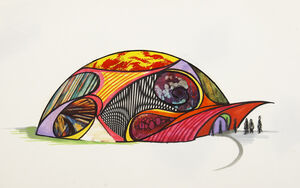
Jim Henson's artwork for the nightclub exterior.
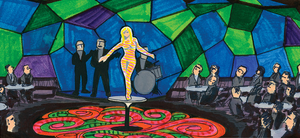
Jim Henson's artwork for the nightclub interior.
Cyclia is a concept for a nightclub that Jim Henson developed from 1965 to 1968. Cyclia was described as "the entertainment experience of the future—a theater of the year 2000."[1]
Henson envisioned that the walls, floors, and ceiling of the club would be broken into faceted, crystal-like shapes onto which films would be projected—completely immersing patrons in a sea of images, choreographed precisely to the volume and type of music being played. Once an hour, a woman in a white leotard would rise from a pedestal in the center of the floor to have film projected on her body as she danced. It would be, as Henson proposed, a very fashionable place, with "a definite prestige atmosphere and as such [the cover charge] would not be inexpensive."[2]
Jane Henson recalled the project's genesis: "The idea began during the first wave of psychedelia. Jim went to see Jefferson Airplane and was very intrigued with it—the light show and psychedelic graphics."[2]
The project's sales brochure called it "a sensational glimpse into the inner contents of our times—a vital, living, expanding experience that consumes its audience. It is total involvement, total communication."[3][1]
Cataclysm
The club would feature an hour-long film called Cataclysm that would be projected constantly on the walls and bodies. Henson began shooting film for the project as early as 1965.
In August 1965, Frank Oz and Jerry Nelson were sent to film the crowd during the Beatles concert at Shea Stadium. Other footage collected included filming city streets from the back of a motorcycle, rain rippling through puddles, wooded landscapes, psychedelic kaleidoscope footage, and original cut paper animations.[4]
Frank Oz commented on the project:
Henson had thirteen different themes in mind—all of which would be edited together into Cataclysm. These themes included: "Woods," "Junk," "City at Night," "India," and "Nude."[2] Music used throughout the film included tracks by the Beatles, Jefferson Airplane, Simon & Garfunkel, and the Rolling Stones, among others.
Location
Henson hired Barry Clark, who had experience managing musicians and clubs, to scout possible locations and help find investors; and Cyclia Enterprises was officially incorporated in the fall of 1967 to help manage the project.
In 1966, Henson considered purchasing and converting ABZ Studios, a set of buildings at 266-268 East 78th Street in Manhattan, to house the club. However, legal difficulties arose with the property and Henson began looking at other locations—including a building on West 60th Street, just off Central Park; a building in Santa Monica, California, and a vacant lot on Second Avenue in New York City at the foot of the Queensboro Bridge where Henson proposed building a geodesic dome or even creating an inflatable structure.[2]
Henson also explored the idea of a joint venture with the El Morocco club on Broadway to take over the club's Garrison Room. El Morocco would deal with all club operations and Muppets Inc., responsible for providing the "motion picture footage," would get 50% of the profits. The two parties would also share future franchising of the concept to other locations.[5]
Eventual abandonment
Despite trouble selling the project and finding a location, Henson remained committed to Cyclia throughout much of 1967 and '68—running multiple cost analyses, editing a rough cut of Cataclysm, creating floor plans, painting concept art and distributing fluorescent-colored brochures to potential backers.[2] While sense-soaking, high-tech themed nightclubs would become fashionable by the late 1970s, in the mid-1960s, Henson struggled to find the necessary space, materials, and technology to make it happen.
Eventually the idea was abandoned as Henson moved on to other projects (such as the production of Hey Cinderella! and the start of Sesame Street); Barry Clark left the project in August 1968 and Cyclia Enterprises was formally disbanded in 1970.
In 1973, Henson pitched the telefilm "Reflections" for IBM, which was described as "an hour of visual poetry." The project would revisit the themes of Cyclia and reuse much of the original video footage Henson had gathered for Cataclysm.
Images and concept artwork from Henson's unrealized Cyclia project were included in the books Jim Henson: The Works and Imagination Illustrated and have been spotlighted on the Jim Henson's Red Book blog.
Sources
- ↑ 1.0 1.1 Jim Henson's Red Book: 7/–/1967 – ‘In LA with Barry C. showing “Cyclia”.’
- ↑ 2.0 2.1 2.2 2.3 2.4 2.5 Jim Henson: The Biography by Brian Jay Jones (pages 124-126)
- ↑ Academy of Motion Picture Arts and Sciences Film Archive: The Jim Henson Collection
- ↑ Imagination Illustrated by Karen Falk (page 52-53)
- ↑ Jim Henson's Red Book: 2/–/1967 – ‘Talking to El Morocco re-Cyclia.’

